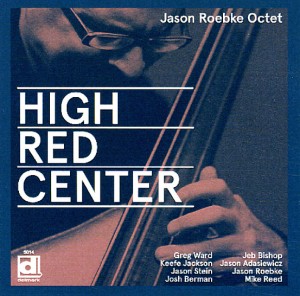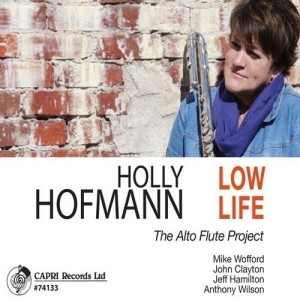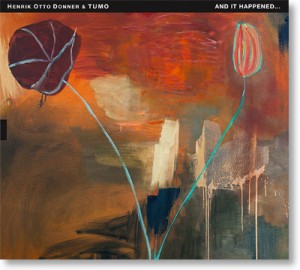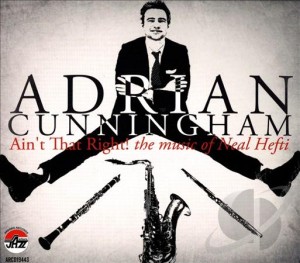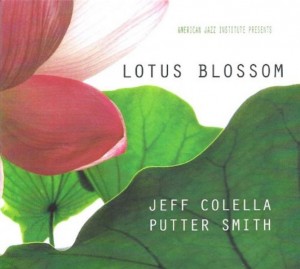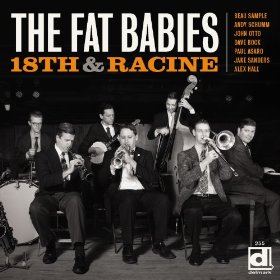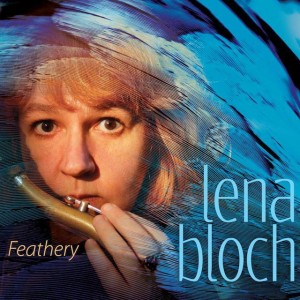Album & Artist Reviews
Artist’s name = Jason Roebke
Genre = Jazz
Title = High/Red/Center
Record company = Delmark
Review =
Though free jazz has existed for over half a century, it remains an acquired taste for many listeners who prefer traditional forms, a reliable beat, attractive harmonies, and hummable melodies. For those who might wish to be introduced to moderately free jazz, I recommend the music of Jason Roebke’s octet, as performed on High/Red/Center. Roebke’s tunes (he wrote them all) combine composition and free improvisation, though where one ends and the other begins is not always obvious. Some are relatively conservative, while others are mainly what might be called out, or at least novel.
Accurately titled, “Slow” is a good starting place. Though composed, it sounds mostly improvised. It begins with miscellaneous, seemingly haphazard squeaks that are possibly the aural equivalent of curlicues on a Miró painting, such as “Antes de Perecer.” Though the squeaks of a few musicians continue throughout the piece, other instrumentalists establish a six-note, riff-like theme over which the curious sounds are played with increasing intensity until the performance subsides into tranquility.
In their apparent randomness, the introductory sounds of “Dirt Cheap” are similar to those of “Slow.” The ones on “Dirt Cheap” are odd, with some resembling gurgling fish, or perhaps someone gargling. At least as surprising as these sounds is what follows them: old-time, slow dance music that hints at the melody of “On the Alamo.” One can imagine a vocalist singing lyrics to it through a megaphone. The beat continues as bass clarinetist Jason Stein solos. As happens on “Slow,” on “Dirt Cheap” the volume increases during the solo; then, it decreases as the group concludes the performance with more dance music. “Dirt Cheap” includes both new and very old music.
Though it has repeated themes (or sound patterns) that are probably composed, the title tune is more adventuresome than “Dirt Cheap.” Over a rhythmic base, it begins with miscellaneous sounds (a Roebke hallmark) that lead to discordant unison playing by the band, à la Sun Ra. Alto saxophonist Greg Ward solos, the band repeats an eight-note phrase, and tenor saxophonist Keefe Jackson solos unaccompanied until the band enters behind him, playing sedately. Vibraphonist Jason Adasiewicz, the leader (on bass), and percussionist Mike Reed interact before being joined by the band. The ensemble concludes this performance abruptly.
Much of the music on this CD is hectic, but some is not. Two selections are melodic, subdued, and lovely. Characterized by pretty harmonies, “Ten Nights” features trombonist Jeb Bishop; Greg Ward is the only soloist on “Shadow,” which has a late-night feeling.
Roebke writes and his group performs ambitious, challenging music that is, nonetheless, accessible. That on High/Red/Center–unpredictable, often cacophonous, and always idiosyncratic–could well serve as a palatable introduction to creative music that is far from mainstream.
Author = Benjamin Franklin V
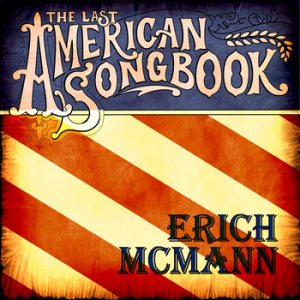 If you have ever read any of my CD reviews, you know that I am a huge fan of traditional country music. I get very excited when out of the crowd of very talented musicians we have in this world, a real country artist emerges. That doesn’t happen often any more. But, it does happen from time to time. When it does, I want to tell you all about it. Today, I found Erich McMann.
If you have ever read any of my CD reviews, you know that I am a huge fan of traditional country music. I get very excited when out of the crowd of very talented musicians we have in this world, a real country artist emerges. That doesn’t happen often any more. But, it does happen from time to time. When it does, I want to tell you all about it. Today, I found Erich McMann.
Erich’s album, “The Last American Songbook” was quite a surprise. While I still don’t like the direction country music is going, I’ve grown to expect it. It seems that country/pop, country/rock, and country/rap are going to be part of the country music scene whether we old folks like it or not. So, try to imagine the huge smile that came across my face when I popped this great CD into my computer this afternoon.
I couldn’t say it any better than the artist did, so I’m going to share his words with you. “This album is an audio snapshot of America, it’s people, music, and culture. Written in a week, recorded in a day, it explores the diverse sonic landscape of Americana through traditional country, western swing, cowboy, folk, trucker, honky tonk and roots music genres,” Erich McMann wrote.
“Inspired by the sights and sounds encountered on a road trip to America’s Heartland, the songs reflect my personal experience as an artist and an American through this journey,” Erich added.
Erich is from the Midwest, born into a musical family. He began picking the guitar at an early age. He said growing up on a farm in the heartland of America exposed him to country music through cross-over country hits on AM radio, and atching Buck Owens’ on “Hee Haw” every Saturday night on television. It was a girlfriend’s father that introduced him to Hank Williams work, and soon after that, Erich began writing and recording.
The songs you will hear on this album are “The Red White and Blue,” “Redneck Hippie 2012,” “My Heart Pounds (When I See Your Face)”, “Keep Me Loving You,” “Back on the Farm,” “The Ghost of Senior Carmello,” “I don’t Need No Woman (To Tell Me How to Drive),” “The Branson, Mo., Summer Blues,” “The Time Has Come,” and “The Last Song”.
In 2013, the song “Keep Me Loving You” was nominated for “Song of the Year” by the Academy of Western Artists.
There is not a bad song on the album. You won’t want to be doing anything else when you are listening to this music. You will want to listen to every word, and see where he is going with the story. I hear a lot of old country coming out in Erich. It was nice to get that back. I’m certain people from my generation are going to fall in love with this music. I hope some of that will reach our younger fans, too. There is a lot of country music they’ve been missing out on. The music is good, the vocals are good. Erich was born to sing country music.
This album is available for free download, by visiting www.erichmcmann.bandcamp.com, and entering a price of zero. If you are a fan of real country music, I know you will enjoy this album as much as I do.
Erich doesn’t have a web site as yet, but keep reading countryschatter.com, and we’ll put up any news we get about him. If you aren’t following us on Twitter, we’d love to have you. You will find us @countryschatter.
Artist’s name = Holly Hofmann
Genre = Jazz
Title = Low Life: The Alto Flute Project
Record company = Capri
Review =
Veteran flautist Holly Hofmann recently participated in two adventuresome recordings. She appears as soloist on Ali Ryerson’s Game Changer, a CD of music performed by a band of flautists (nineteen of them, including guests) plus rhythm section. Hofmann plays C flute on this 2012 release. (A review is available at http://www.musicchartsmagazine.com/ali-ryerson-game-changer-review-by-benjamin-franklin-v-of-music-charts-magazine-tm/.) The other session is one she led. Apparently recorded in 2013 (I say apparently because the CD identifies the recording date as 18 December 2014, which has not yet arrived), Low Life showcases Hofmann with a trio (sometimes a quartet) and playing alto flute exclusively.
Though C flute is her primary instrument, Hofmann has featured alto flute occasionally. The latter has a mellower sound and more limited range than the former. As a result, performances on alto flute typically convey warmth and avoid displays of virtuosity. A complete CD of such music risks causing boredom because of sonic uniformity.
Hofmann attempts to solve this problem in various ways: by playing unison lines with guitarist Anthony Wilson, who appears on four selections and who wrote one of them, “Jack of Hearts”; by soloing only with the accompaniment of pianist Mike Wofford; by letting others solo, especially Wilson and Wofford; by adding a percussive element by having drummer Jeff Hamilton engage in four-bar exchanges with other instrumentalists; and by performing at various tempos, from the slow “The Very Thought of You” (the only standard played here) and her own “Lumière de la Vie” to the middle-groove “Cedar Would,” composed by bassist John Clayton, and the funky “Soul-Leo,” by the late pianist Mulgrew Miller. In other words, she did all she could to add texture to her music.
An interpretation of Pat Metheny’s “Farmer’s Trust” concludes the CD. Hofmann declares that she recorded this piece because her live performances of it moved some listeners to tears. Her lovely and emotional version of it on Low Life makes her claim believable. She states the melody and is the only soloist, though Wilson is much in evidence, both when performing in unison with her and when playing behind her solo.
Hofmann creates appealing music throughout this CD. The question becomes: Should she record another alto flute album? This is up to her and her producer, but I think that unless she can conceive of additional ways to add variety to her performances she might best be advised to feature the instrument on a track or two on subsequent releases and let Low Life stand as her sole but impressive all-alto flute album.
Author = Benjamin Franklin V
Artist Name = Henrik Otto Donner and TUMO
Genre = Jazz
Title = And It Happened
Record Company = TUM Records
Review =
Recorded in Helsinki in 2012, this CD features the compositions of Henrik Otto Donner (1939-2013), a Finn who wrote prolifically in various genres and was a respected trumpeter. Performed by the orchestra TUMO (Donner conducts the strings; Mikko Hassinen leads the other musicians), the pieces on this release primarily create mood, which is frequently tranquil. Occasionally, though, there are emotional outbursts that, when played by the brass, remind me of the shrieking trumpets and trombones of Stan Kenton’s extroverted band. This is especially evident on the title track. The difference between Donner’s and Kenton’s use of blaring sound is that Donner incorporated it for contrast (the wildness near the end of “And It Happened” subsides and the performance concludes with a musical whisper), while Kenton employed it so commonly that its excessiveness came to characterize his group’s sound. Additionally, Donner’s music is modest in the sense that it often serves less as an end unto itself (drawing attention to itself) than as a setting and inspiration for the major soloists, in this case tenor saxophonist Juhani Aaltonen (a collaborator of Donner since the 1960s) and vocalist Johanna Iivanainen.
A fixture on the Finnish jazz scene since the 1950s, Aaltonen is a marvel. Not only does he play masterfully—both sensitively and passionately, as appropriate–but his solos belie his age: at the time of this recording, he was past his mid seventies. I have not heard many soon-to-be octogenarian instrumentalists express such emotional breadth and depth, though this quality of playing would impress if played by someone far younger than Aaltonen. He does justice to Donner’s compositions. For an example of his current work as leader, I recommend To Future Memories (2010), a sextet session issued recently by Finnish TUM.
Though English is not Iivanainen’s first language, the Finn could possibly be mistaken for a native speaker because she shows only the slightest hint of accent. In fact, many singers could learn something valuable from her: the importance of enunciation. When she performs, every syllable is easily understood. Why sing lyrics, which exist to tell a story, if they cannot be fully comprehended, as is too often the case? She communicates a story.
Of the eight selections on this CD, two in particular surprised me: “These Are the Days” and “For Friends and Relatives.” The first is a musical rendering of a poem by Emily Dickinson (my favorite from among her creations), with the words sung by Iivanainen and featuring Aaltonen on alto flute and Kasperi Sarikoski on trombone. As straightforward and attractive as this performance is, I cannot determine if it suggests what I think is the meaning of the poem: the skeptical speaker’s desire to possess an innocence that would permit her to gain salvation by uniting with Christ through Holy Communion. If Donner and the musicians intended not to interpret the poem but merely to make lovely music behind the vocalist, they succeeded. Donner’s first recorded composition (1963) and the jazziest performance on the CD, the second tune surprises because the beginning of its melody (after the few bars of fanfare) seems inspired, to a degree, by the music of Charles Mingus, including a fragment from “Ecclusiastics,” recorded the year before the initial recording of “For Friends and Relatives.” Perhaps Mingus is one of the friends alluded to in the title.
In sum, And It Happened serves as a good introduction to Donner’s writing, Aaltonen’s playing, Iivanainen’s singing, and an aspect of the recent Finnish jazz scene.
Note: Donner wrote the “Close Your Eyes” that is performed on this CD; it is not Bernice Petkere’s popular tune of this title written in the 1930s.
Author = Benjamin Franklin V
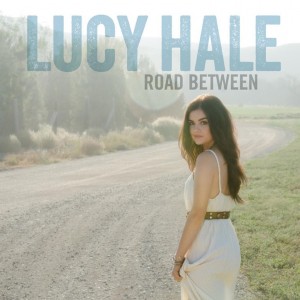 A lot of people know Lucy Hale from her role as Aria Montgomery in the television series Pretty Little Liars. The actress recently released her first album, “The Road Between”.
A lot of people know Lucy Hale from her role as Aria Montgomery in the television series Pretty Little Liars. The actress recently released her first album, “The Road Between”.
The album was produced by Mark Bright and Mike Dailey. There is a song Kacey Musgraves had a hand in writing; a song that Joe Nichols sings on, and even one that Lucy co-wrote. On this album, you will find love songs, break-up songs, songs about life, songs that tell stories, and songs that you can relate to.
Here are the songs, along with the writers, that you will hear on this new album. “You Sound Good To Me,” Ashley Gorley, Luke Laird, Hillary Lindsey; “From The Backseat,” Mike Daly, Jimmy Robbins, Nicolle Clawson; “Nervous Girls,” Hillary Lindsey, Tom Douglas, James Slater; “Red Dress,” Todd Sherman Clark, Jessica Lee Mitchell; “Goodbye Gone,” J.T. Harding, Melissa Peirce, Andy Dodd; “Kiss Me,” Mike Daly, Chris DeStefano, Ashley Gorley, Lindy Robbins; “Road Between,” Melissa Peirce, Mike Daly; “Lie A Little Better,” Melissa Peirce, Mike Daly, Chris DeStefano; “That’s What I Call Crazy,” Ashley Gorley, Chris DeStefano, Kacey Musgraves; “Love Tonight,” Lucie Silvas, Jeremy Spillman, Jonathan Ian Green; and, “Just Another Song,” Mike Daly, Lucy Hale, Catt Gravitt.
I’m not going to give you a ‘track-by-track’ review of all 11 songs. But there are a few I want to talk about. “From the Backseat” is one of my favorites. Not the melody, or the tempo, but the story. It tells you that you can really learn a lot watching how people treat each other. The song talks about how the people in the front seat could see the road ahead better than the ones in the backseat could; the front seat passengers could touch dials and controls. But, from her spot in the backseat, she learned about how much they loved each other. And, how they showed each other that love.
Joe Nichols joins Lucy on the song, “Red Dress”. This is a love song, but seems to be more about looking back at the things a couple is remembering in their relationship. Even though it’s obvious they are still a couple, and this isn’t about one of them walking out on the other one, it’s still more about remembering than about what is going on right now. It’s up-tempo, it’s catchy, it’s a fun song.
“Just Another Song” is the last one on the CD. It is one that Lucy co-wrote. I don’t know how much input she had, but it made me wonder why that was the only one she co-wrote. It’s a good song, much different than the others on the album. It’s a slow, sad, song about ending a relationship. It isn’t a sassy, fun, break-up song, like you will hear with “Goodbye Gone”. In that one, you hear not only about breaking up, but about the freedom you have after the breakup happens.
The title track, “Road Between” Is my very favorite on the entire album. It’s about life. It’s about where we’ve been, where we’re going, and what’s in between. The bad parts, the good parts, the breaking down, the writing my story, winning, losing, from the start to the end, still learning what’s in between. I love this one. Melissa Peirce and Mike Daily seem to have taken everything that everyone of us goes through in life and put it in one song.
One song that seems to be about every woman out there is “Nervous Girls”. All women have different problems, different thoughts, different dreams, different ideas – but by the time you get to the end of the song, you realize that we really aren’t that different at all. The lyrics are thought provoking. While this isn’t a song I expect to hear on the radio, it is a good addition to the album.
You can keep up with Lucy by visiting her web site, www.lucyhale.com, and follow her on Twitter @lucyhale. For all your country music news, visit www.countryschatter.com. You will find us on Twitter @countryschatter.
Artist’s name = Adrian Cunningham
Genre = Jazz
Title = “Ain’t That Right!” The Music of Neal Hefti
Record company = Arbors
Review =
Trumpeter Neal Hefti played in bands led by Benny Carter, Woody Herman, Harry James, and others, and recorded with the likes of Billie Holiday and Lucky Thompson. In time he led his own band. Yet he is most important as a composer and arranger. He made his mark on popular culture by creating the theme for the television series Batman and producing scores for such movies as Barefoot in the Park and The Odd Couple. His writing contributed significantly to the smaller world of jazz. He wrote for many groups and arranged for jazz-oriented singers, including Peggy Lee, Frank Sinatra, and Mel Tormé. He arranged the music for the masterful Clifford Brown with Strings. His major contribution to jazz resulted from composing and arranging for the Count Basie band in the 1950s. The tunes immediately entered and forever remained in Basie’s book. Partly because of his arrangements of them, the focus of the band changed. Previously, it had used arrangements primarily to set up solos by such musicians as Buck Clayton and Lester Young. In the 1950s, the arrangements of Hefti and others required the band to focus more on the arrangements themselves than on solos, though the band included solid soloists, including Eddie “Lockjaw” Davis, who is especially forceful on Basie (also known as The Atomic Basie), the initial Basie album of Hefti’s compositions and arrangements.
Australian Adrian Cunningham performs only Hefti’s music on his newest release, and such a tribute is welcome. Though he plays some of the composer’s most familiar tunes, many are not well known. Among the latter, surprises abound. “It’s Awfully Nice to Be with You” is a pretty melody that Cunningham interprets slowly on clarinet and that features pianist Dan Nimmer. “Ain’t That Right” and “I’ve Got Love” are in a gospel vein. Of these less familiar tunes, I find most rewarding “Zankie,” a blues Hefti wrote for the movie Synanon. Cunningham (again on clarinet) takes it at an attractive deliberate tempo.
In the notes to this release, Will Friedwald comments about Cunningham’s probable rationale for omitting some Hefti tunes. He writes: “Some works are not included for the apparent reason that they’ve already been played so definitively that no one wants to come up with something that would, in all likelihood, be compared unfavorably to the iconic recordings.” He identifies “Splanky” as a composition possibly rejected for this reason. His statement implies that the tunes Cunningham performs have not been recorded definitively. Though people can disagree about what constitutes a definitive recording, at least two of the tunes Cunningham chose to release strike me as not having been surpassed since Basie recorded them in the 1950s: “Li’l Darlin’” from Basie and “Cute” from the follow-up album, Basie Plays Hefti. If one believes that Basie’s recordings of these compositions are iconic (perhaps Friedwald does not so consider them), then, according to Friedwald, later versions—such as Cunningham’s—might reasonably be compared with them.
The original “Li’l Darlin’” is probably one of the slowest big band recordings: it creeps along, with the beat sustained primarily by the light, almost unnoticeable guitar strumming of Freddie Green and bass plucking of Eddie Jones. Cunningham’s tempo is a little faster than Basie’s, but the beat on Cunningham’s is heavy, not subtle. Further, Cunningham (here, on tenor saxophone) is joined by trombonist Wycliffe Gordon. The two men do as well as could be expected in creating harmonies reminiscent of those Basie produced with an entire band. However, Gordon’s gutbucket playing during his interjections seems inappropriate on a tune of such delicacy. Within the context of Friedwald’s comment, Cunningham should not have released this recording of “Li’l Darlin’,” unless he did not mind having it compared with Basie’s version.
Basie first recorded “Cute” as a feature for flautist Frank Wess and drummer Sonny Payne, on brushes. This skittish performance is all surface, precisely as suggested by the nature of the composition and implied by the title. There are several differences between Basie’s and Cunningham’s treatments of it. Cunningham’s tempo is slower than Basie’s. Though Cunningham is an able flautist, here he plays tenor saxophone; drummer Chuck Redd uses sticks, not brushes. After the melodic statement, Cunningham’s recording turns into a typical jazz performance, with solos by the leader and the pianist before Cunningham and Redd interact toward the end. This selection concludes without restating the theme. That is, Basie honors the composition while Cunningham uses it as a means of getting to blowing. Cunningham’s version is valid—using a composition as a taking-off point for improvisation—but it is exceptional only in the sense that it is different from any other interpretation of “Cute” of which I am aware.
Despite Cunningham’s and Basie’s different approaches to some of the tunes presented on this release, the playing of Cunningham and his sidemen is engaging. Perhaps this CD of Hefti tunes will help this able, inventive instrumentalist become better known than he is outside Australia, as he deserves to be.
Author = Benjamin Franklin V
 I wasn’t familiar with Rachele Lynae until I listened to her self-titled debut album. When I started listening, I immediately headed over to her web site to read her bio, and find out a little more about her. She grew up in Kodiak, Alaska, and started singing at a very early age. By the time she was 10 years old she had already been singing in church for five years. She started writing songs when she was 12, and at age 17 she started doing live shows, and building a reputation as a ‘riveting live performer’.
I wasn’t familiar with Rachele Lynae until I listened to her self-titled debut album. When I started listening, I immediately headed over to her web site to read her bio, and find out a little more about her. She grew up in Kodiak, Alaska, and started singing at a very early age. By the time she was 10 years old she had already been singing in church for five years. She started writing songs when she was 12, and at age 17 she started doing live shows, and building a reputation as a ‘riveting live performer’.
She moved to Nashville to attend Belmont University. That is a great music school, and is also where Josh Turner, Trisha Yearwood and Brad Paisley went to school. Rachele has been performing at Nashville’s famous clubs, and recorded a five song EP, which shared with Jimmy Murphy – who shared it with his daughter, Jamie O’Neal. That was all it took.
Jamie and Rachele began working on the new album. Rachele co-wrote every song on the album, Jamie produced it. Four of the songs even had Jamie in that ‘co-writer’ seat.
“Done is Done” was written by Rachele and Luke Sheets. The title pretty much tells you what to expect from the song. Someone is about to get their heart broken. Someone is leaving. What is “Done is Done”. There aren’t any surprises with this song, and yet it was one of my favorites. Her vocals, which are so strong and so powerful in some of the faster songs, actually have a softer side. Even when Rachele slows things down, she still has perfect control, and perfect tone. And she still makes you want to see her on stage.
I jumped all the way down to the 10th track (Done is Done) there – let me list them all for you, in order, with their writers, and tell you a little about some of the rest of them. Here is what you are going to get on this new album: Touch the Stars, Rachele Lynae, Danick Dupelle, Patricia Conroy; Words in Red, Rachele Lynae, Kyle Stallons; Cigarette, Rachele Lynae, Katelynn Beckett; Sometimes You Fly, Rachele Lynae, Luke Sheets; Party Til the Cows Come Home, Rachele Lynae, Jamie O’Neal, Stephanie Bentley, Jimmy Murphy; Fishin for Something, Rachele Lynae, Hannah Bethel; Clean, Rachele Lynae, Justin Halpin; Out On the Floor, Rachele Lynae, Jimmy Murphy, Jamie O’Neal; Sticky Summer Lovin, Rachele Lynae, Jamie O’Neal, Hannah Bethel; Done is Done, Rachele Lynae, Luke Sheets; Two for One Special, Rachele Lynae, Jamie O’Neal, Shaye Smith; Old Fashioned Love, Rachele Lynae, Josh Holiday.
By the time I got to the end of the album, I realized I had a lot of favorite songs. Leading the pack for me are “Done is Done” and “Sometimes You Fly,” but if they don’t end up being your favorites, no need to worry! You are definitely going to find a lot you like among the 12 songs on this CD. The first song very much falls into the category of ‘country/pop’, and is very much like a lot of the songs you hear on today’s Top 40 stations. It is an upbeat song, and I can’t imagine Rachele being able to stand still and sing that one.
The second song, “Words in Red” gave her a great opportunity to showcase her vocals. With a title like “Cigarette” I wasn’t really sure what to expect from this song. But it’s a great song. I think we will all understand the lyrics, and I think most of us have probably been there at one time or another. The song is about regret.
I don’t know what Rachele plans on releasing as a single, but if I were asked, I would to point to “Clean”. This song made me think about growing up’’; about my family; getting hurt as a kid; Mom always being ready with warm, soapy washcloth; church; leaving home; and, coming back. All that in addition to the fact that it is a beautiful song, being sung by an artist with a beautiful voice. This song, more than any of the others on this album, sounds ‘country’ to me. It isn’t country/rock, or country/pop, or country/soul, or country/blues, or country/jazz … it is country.
“Old Fashioned Love” is another great ballad. I like songs that have memorable lyrics. After listening to the album three times, I found myself singing along with this one – and actually waiting for it to come around again.
Regardless of your taste, you are going to find music on this CD that you like, and you will find music that will make you want to sing, dance, tap your feet, close your eyes and relax, think back, and play again.
To learn more about Rachele, visit her web site at www.rachelelynae.com. You can also follow her on Twitter @Rachele Lynae. Keep up with all the latest country music news at www.countryschatter.com, and follow us on Twitter @countryschatter.
Music Charts Magazine Country music CD Review of Dolly Parton - Blue Smoke - by Donna Rea /of the website we all know and love: www.CountrysChatter.com
Artists’ names = Jeff Colella and Putter Smith; Jeff Denson and Joshua White
Genre = Jazz
Title = Lotus Blossom; I’ll Fly Away
Record companies = American Jazz Institute; pfMENTUM
Review =
Though I cannot identify the first recorded piano-bass duet, Duke Ellington and Jimmy Blanton recorded four duets in 1940. Oscar Pettiford (later to be Ellington’s bassist) recorded two with pianist Clyde Hart in 1944, one dedicated to Blanton, though this music is not known to exist. Bassist Red Mitchell recorded two albums of duets with pianists, one with Guido Manusardi (1974) and another with Kenny Barron (1986). Bassist Ray Brown recorded three such albums, two with Jimmy Rowles in the late 1970s and, early that decade, one with Ellington titled This One’s for Blanton. Beginning with a session with Hampton Hawes in 1976, bassist Charlie Haden might have been involved in more duet recordings than anyone, having also participated in sessions at least with Chris Anderson, Kenny Barron, Egberto Gismanto, and Hank Jones. Piano-bass duets continue being performed, as two recent CDs illustrate.
Pianist Jeff Colella and bassist Putter Smith recorded together initially in the 1990s. They recently reunited for an album of duets linked by mood, which is mainly subdued, introspective. As a result of the deliberate tempos, one can hear every note and appreciate the interplay between the two men. Colella states the melodies and Smith supports him, always playing pizzicato. While they both solo attractively and together do justice to the compositions, I am most smitten by their conception.
Consider Miles Davis’s “All Blues.” During Smith’s introduction, Colella announces his presence with five spaced dissonant chords. The pianist strikes similar chords at the end of the second blues chorus and a few bars into the third, but also at the conclusion of the performance, which otherwise ends without resolution. That is, his chording constitutes a unifying device, a motif.
Daringly, the musicians draw attention to the briefest selection (3:28) by titling the CD Lotus Blossom. Why daringly? 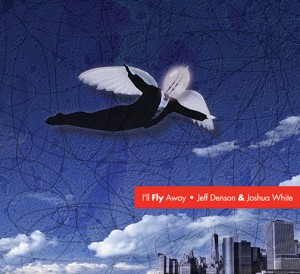 This lovely, simple tune was written by Billy Strayhorn, Ellington’s songwriting associate. While musicians were packing at the conclusion of a recording session three months after the composer’s death in 1967, Ellington sat at a piano and played “Lotus Blossom” unaccompanied, with Strayhorn obviously in mind. Fortunately, the tape kept running so the music was preserved. Probably the most moving performance of Ellington’s long career, “Lotus Blossom” is pure emotion. Because it is, any recording of Strayhorn’s composition will likely be compared with Ellington’s and risk being deemed inferior. Possibly as a result—or because of the inherent nature of the composition--musicians performing “Lotus Blossom” follow Ellington’s example by treating it respectfully, ruminatively. With Smith discreetly in the background, this is precisely what Colella does in his interpretation that, though less deep than Ellington’s, is beautiful nonetheless. It succeeds on its own terms.
This lovely, simple tune was written by Billy Strayhorn, Ellington’s songwriting associate. While musicians were packing at the conclusion of a recording session three months after the composer’s death in 1967, Ellington sat at a piano and played “Lotus Blossom” unaccompanied, with Strayhorn obviously in mind. Fortunately, the tape kept running so the music was preserved. Probably the most moving performance of Ellington’s long career, “Lotus Blossom” is pure emotion. Because it is, any recording of Strayhorn’s composition will likely be compared with Ellington’s and risk being deemed inferior. Possibly as a result—or because of the inherent nature of the composition--musicians performing “Lotus Blossom” follow Ellington’s example by treating it respectfully, ruminatively. With Smith discreetly in the background, this is precisely what Colella does in his interpretation that, though less deep than Ellington’s, is beautiful nonetheless. It succeeds on its own terms.
While mood characterizes Colella and Smith’s CD, bassist Jeff Denson and pianist Joshua White’s is unified by the nature of the tunes, which are religious in nature. Their CD gets off to a rousing start and concludes with a bang with different versions of “I’ll Fly Away.” (A third version is more restrained.) Raucous and dissonant, these two selections are, with “Just As I Am,” the most extroverted pieces on this release, though other ones have passionate moments. Yet Denson and White also demonstrate an ability to sustain a performance at a slow tempo. For example, their deliberate treatment of “What a Friend We Have in Jesus,” the longest selection, permits the natural beauty of the composition to emerge. Played not quite so slowly, “In the Garden” is similarly attractive, and moving. On all nine tunes the instrumentalists play together, they interact engagingly. Though Denson solos, he is most important when keeping the beat during White’s adventuresome solos. White’s playing sometimes reminds me of Don Pullen’s.
Denson performs two tunes unaccompanied, “Crying in the Chapel” (pizzicato) and “Amazing Grace” (arco). Played slowly, the latter is more impressive than the former. On “Amazing Grace” he makes multiphonic sounds that lead one to wonder if they result from overdubbing. (They do not.) This technique creates great interest in his version of this revered song that, at least for me, long ago entered the realm of cliché, possibly because I have heard it at so many funerals.
Though different in almost every way other than instrumentation and a high level of musicianship, these two CDs delight. With varied selections, the first is similar in mood throughout. With unified selections, the second has a wide range of moods. Both duos make meaningful contributions to the tradition of piano-bass duets possibly initiated by Duke Ellington and Jimmy Blanton in 1940.
Author = Benjamin Franklin V
Artist name = The Fat Babies
Genre = Jazz
Title = 18th & Racine
Record company = Delmark
Review =
Why is it that some established forms of improvised music are more valued than others? Though bebop developed in the early 1940s, for example, it is possibly the form of jazz played most frequently. Traditional jazz, however defined, is less highly regarded. One reason for this disparity might be that the more modern music is complex and therefore demanding while the older is sometimes simple and presumably easy to play. Bebop is still capable of yielding surprises; traditional jazz, less so. On “High Society,” can any traditional clarinetist escape the influence of Alphonse Picou’s solo from the distant past?
Whatever the answer(s) to the question, traditional jazz continues being performed by serious musicians. Vince Giordano’s Nighthawks is probably the most notable traditional group; bassist Beau Sample’s Fat Babies is another one. Founded in 2010 and headquartered in Chicago, this septet plays compositions mainly from the 1920s and early 1930s. Its music is vital partly because most of its repertoire, as represented on 18th & Racine, is not overly familiar. Yes, “Stardust” is one of the most popular tunes in all of American music and anyone interested in traditional jazz doubtless is aware of “Nobody’s Sweetheart,” but the remaining thirteen selections are less well known. Among them are creations by such stellar musicians as Fletcher Henderson, James P. Johnson, Jabbo Smith, and Clarence Williams.
So what does the band bring to these more-or-less neglected compositions from long ago? At least two things: First, it plays well and energetically; second, it performs some tunes in a manner consistent with the original recordings of them while refashioning others. Consider the second point. Despite being twenty seconds longer than Jabbo Smith’s recording of “Till Times Get Better,” the septet’s version follows the structure of Smith’s. Both begin with a piano introduction (including three identical opening notes). Then, the cornet states the melody, a musician sings, the clarinet solos, and the cornet concludes the piece. The group takes liberties with Fletcher Henderson’s “The Stampede,” giving the opening melodic statement to the cornet rather than the ensemble and otherwise redistributing the solos among the horns; the new recording is over a minute longer than Henderson’s. In other words, the band’s approach to its material is not predictable.
Two selections require special comment. The corny vocal on “I’ll Fly to Hawaii,” recorded initially by Brad Gowans in 1926, makes it irredeemable. This might be the first recording of the tune since the second recording of it--by Julian Fuhs in 1927. The reason for its neglect is obvious. With many old songs worthy of reconsideration, I wonder why leader Sample chose “I’ll Fly to Hawaii” for inclusion on this CD. James P. Johnson’s “Blueberry Rhyme” is a piano solo by Paul Asaro, backed only by drummer Alex Hall on brushes. The composer recorded it twice (1939, 1943), both times as an unaccompanied piano solo. It became something of a favorite of Asaro, who recorded it at least four times as leader, all in 2004. That his and Hall’s version is polished therefore comes as no surprise.
The music on 18th & Racine shows that in the hands of spirited instrumentalists, traditional jazz played unpredictably is still viable.
Author = Benjamin Franklin V
Artist Name = Lena Bloch
Genre = Jazz
Title = Feathery
Record Company = Thirteenth Note
Review =
Among the jazz musicians born in Russia are Buzzy Drootin, Valery Ponomarev, Alexei Kuznetsov, members of the Ganelin Trio (Vladimir Chekasin, Vyacheslav Ganelin, and Vladimir Tarasov), and possibly Charlie Spivak. To this list may be added Lena Bloch, hitherto unknown to me. Born in Moscow, the tenor saxophonist has led, since 1989, a peripatetic life: Israel, Holland, Germany, United States, Germany again, Canada, Germany yet again, and finally United States, this time initially in Boston but then in Brooklyn, where she currently resides. Along the way she received a degree from the Cologne Conservatory and attended graduate school at the University of Massachusetts, Amherst. In Europe around 1991 she began playing professionally, including with the rock group Embryo and as leader of her own quartet. Soon thereafter she met alto saxophonist Lee Konitz, who introduced her to music that would inspire her from then until now. This is the music of pianist-composer-theorist-teacher Lennie Tristano (1919-1978) and his associates Ted Brown and Warne Marsh, both tenor saxophonists; himself a Tristano student and colleague, Konitz is the best known musician of what might be called the Tristano School. As Feathery demonstrates, Bloch is, apparently, the most recent instrumentalist influenced by Tristano and dedicated to keeping alive his precepts, as practiced by his acolytes. She creates music well worth hearing and taking seriously.
Bloch is possibly most indebted to Marsh and Brown in matters of tone: like theirs, hers is dry, with little vibrato. She plays cleanly by articulating individual notes and avoiding flurries of sixteenth notes. Each note matters. This tendency is perhaps most obvious on “Baby Suite” and “Starry-Eyed.” On the former, she plays strings of single notes, each note followed by a rest; on the latter, which is really the standard “Star Eyes,” she usually pauses between the notes that correspond to the words “star” and “eyes,” “eyes” and “are,” and “skies” and “are” when sung. This separation of notes creates an airiness that parallels the tone she gets from her horn. Especially at slow tempo, her technique has the effect of forcing the listener (this listener, anyway) to focus intently on her playing. (Altering aspects of a popular tune and renaming it is part of the Tristano tradition. His “Lennie’s Pennies,” for example, is a reworking of “Pennies from Heaven.”)
Bloch drew on Marsh and Brown for two of the tunes included on Feathery. Though not flagwavers, they are the most
Lena Block - Feathery - Music Charts Magazine Jazz CD Review by Benjamin Franklin V
sprightly performances on the CD. Marsh’s “Marshmallow” is based on the chords of “Cherokee”; Brown’s “Featherbed,” on those of “You’d Be So Nice to Come Home To.” She acknowledges Konitz with an original tune titled “Hi-Lee,” which alludes to his composition “Hi Beck.”
If the Marsh and Brown compositions are up-tempo, guitarist Dave Miller’s “Rubato” is the opposite. Though it contains a section of relatively energetic playing, that section is framed by music performed at a dirge-like tempo. Amazingly, the group, a quartet, engages in effective collective improvisation at this tempo. Billy Mintz’s drum solo is so slow that it barely moves. As with Bloch’s own playing, though, this deliberateness—almost stasis—forces the listener to focus on the sounds Mintz creates. Bassist Cameron Brown—a major presence throughout the CD and the composer of “Baby Suite”—plays arco, while Miller provides chords and joins the leader in unison passages. “Rubato” is an impressive performance.
Yet all the music on this release is impressive. Feathery signals the arrival of a significant musician, Lena Bloch. Not only does she help keep alive the Tristano tradition, but her music is among the most stimulating I have heard recently.
Author = Benjamin Franklin V
